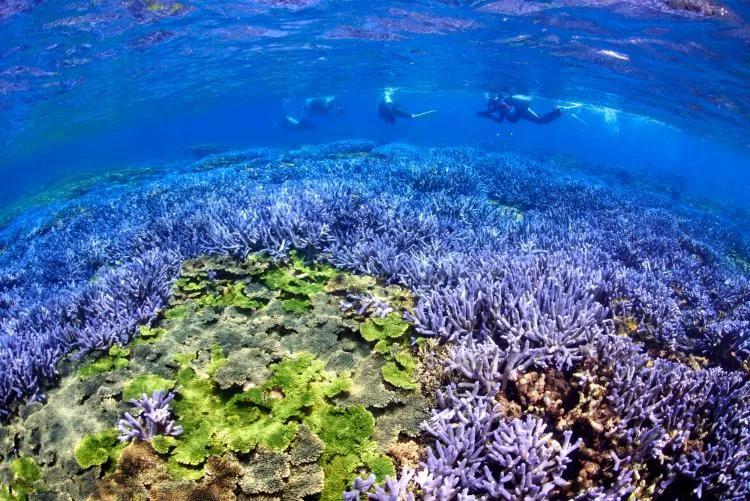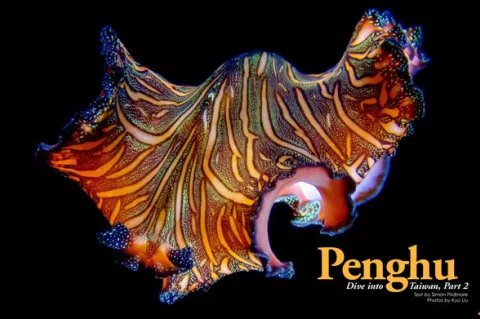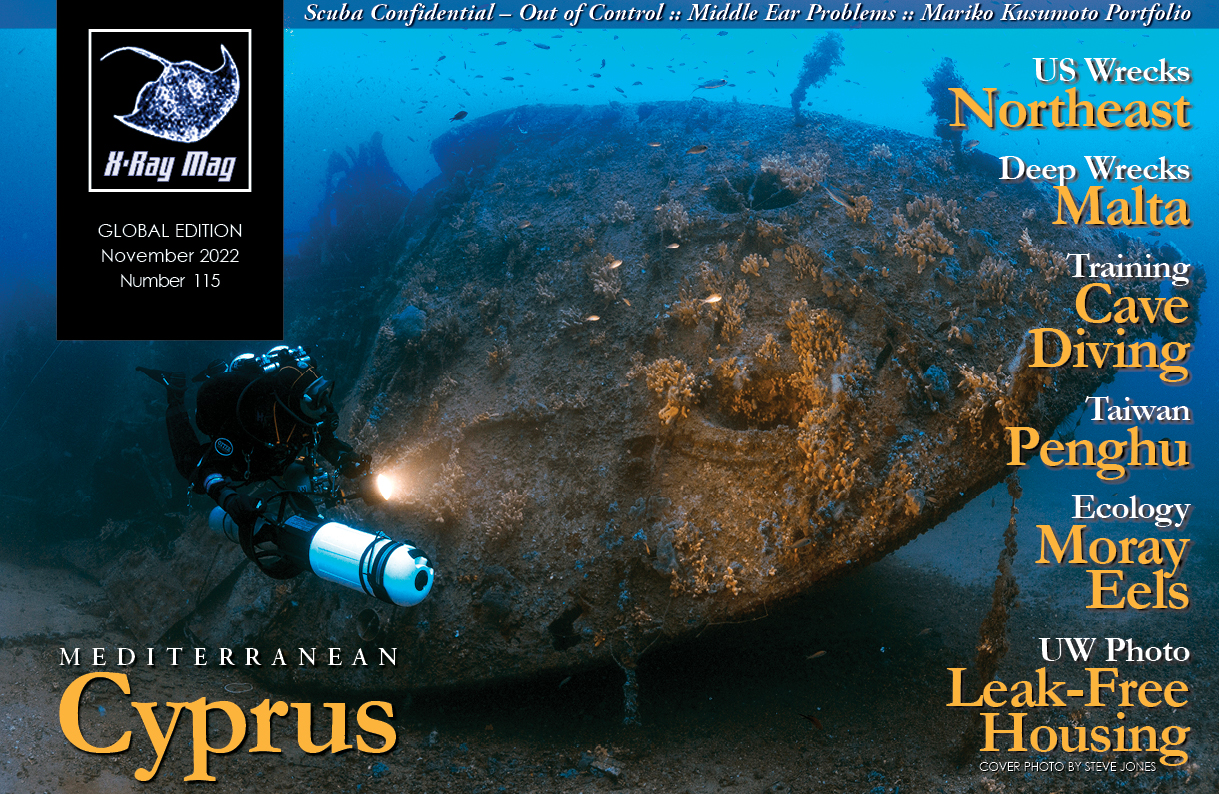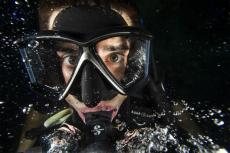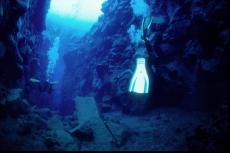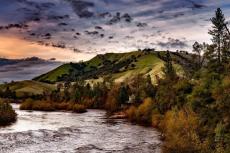The Penghu Islands, an archipelago of 90 islands and small rocks in the middle of the Taiwan Strait, is a location of incredible landscapes with unique basalt columns and is home to some of Taiwan’s most beautiful beaches and marine protected areas, which offer some of the best diving in Taiwan. Simon Pridmore has the story.
Contributed by
Taiwan is a group of Pacific islands surrounded by warm tropical seas. It is easy to get to and get around, and it is a first-world society with outgoing, friendly, laid-back people. Taiwan offers some very good scuba and a network of dive centres and resorts, with first-class professional staff, equipment and services. They offer scuba experiences, basic training courses and fun diving for a young, enthusiastic first generation of Taiwanese divers.
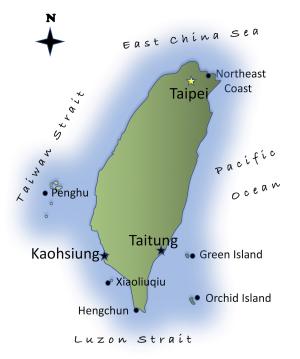
Yet, when divers elsewhere in the world think about diving destinations, Taiwan is unlikely even to be a blip on their radar screen. Very few people outside Taiwan have ever thought to enquire about the diving there, and very few people inside Taiwan have ever thought to tell anyone about it. That was until a couple of years ago, when some far-sighted folks asked me and Taiwanese underwater photographer Kyo Liu to write a book.
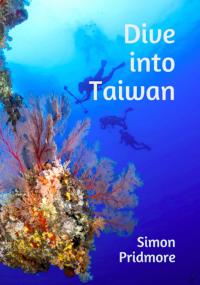
The book is called Dive into Taiwan, and this is the second in a series of six articles, each covering one of Taiwan’s diving regions, designed to give you a flavour of what to expect from a Taiwan dive trip. The book covers much more than diving. It talks about the people, countryside, cities, food and lifestyle to give readers a fully immersive experience—diving into Taiwan in every way. But, in this series, I will just focus on the underwater attractions, with the help of Kyo’s amazing photographs.
Penghu
You have probably never heard of Penghu. Yet, it is a substantial archipelago consisting of 90 islands and small rocks in the middle of the Taiwan Strait and its main city of Magong is home to 60,000 people. The Penghu Islands are a spectacular geological marvel, they have some of Taiwan’s most beautiful and deserted beaches, and a Marine Protected Area (MPA) that has arguably the best diving in Taiwan.
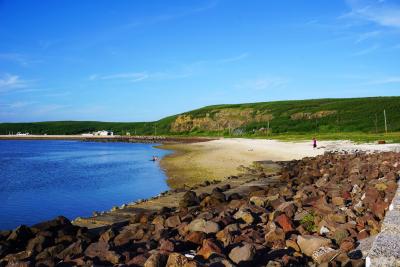
There are a few diving operations in Magong City, but they tend to concentrate on providing scuba experiences and beginner courses for non-divers. The sites are all shore dives, and the most distinctive of these is off Suogang Village on Penghu, where there is a submarine mailbox at a depth of around 5m. Local dive centres sell waterproof cards for divers to send underwater wishes to friends and family—written in waterproof ink, naturally. The centres then take turns emptying the mailbox and posting the cards off.
Experienced, adventure-seeking divers, however, will eschew the beaches of Magong and head straight down to southern Penghu for boat diving and some more challenging sites. There is only one dive operator currently offering dives inside the MPA and it runs 4-day/3-night packages between April and September, with pick-up from Magong Harbour early on day one and drop-off early on day four (which is day one for the next group). They have only one boat and it carries a maximum of 24 divers, which means that the sites in and around the MPA see fewer than 700 divers per year.
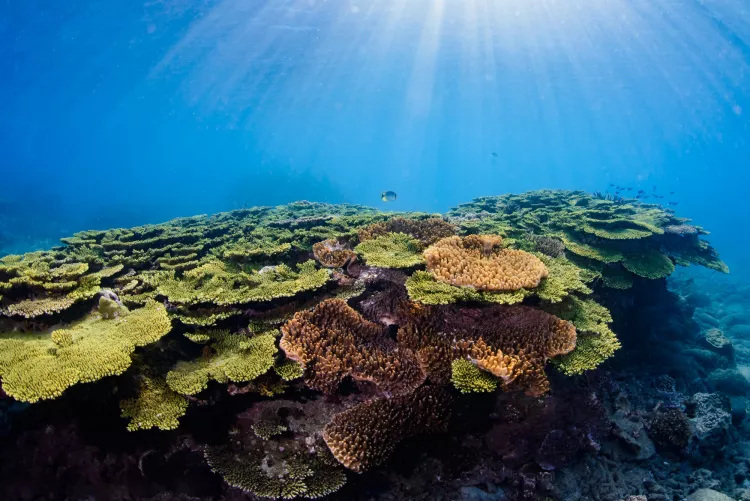
A typical South Penghu dive trip
You need to be at the dock early for a 9:30 am departure. It is already hot but, if you get there early, there is plenty of shade available. The dive boat appears and offloads the people from the previous trip to make room for you. The boat has a covered dive deck with tank racks and the air-conditioned cabin has rows of seats like a small ferry.
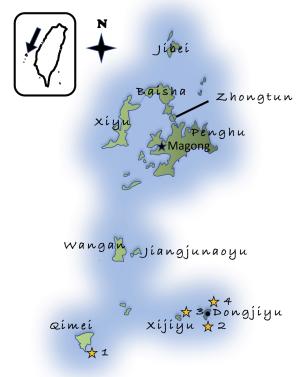
The journey to Jiangjunaoyu takes about 45 minutes. You can chill in the aircon, but the best views are from the dive deck, especially as you pass tiny Tongpanyu and long, thin Hujingyu soon after leaving Magong. Both islands have long coastal ridges of basalt pillars and old, long-disused pillboxes and gun emplacements wedged into the cliffs.
You soon enter a narrow strait with the flat expanse of Wangan Island on the right and, on the left, Jiangjunaoyu, your home for the next three days. In the harbour, fishing boats are lined up at the docks on all sides. Your cylinders are waiting for you in front of the blue walls of the Island 77 Dive Centre. You unpack fins, BCDs and regulators and leave them beside the boat for the crew to load.
After lunch, you reboard the boat and head south towards the MPA, passing a series of rocks that, in summer, provide a temporary home for thousands of migrating terns. Your first dive will be a checkout dive in a shallow bay, where there is little current or wave action.
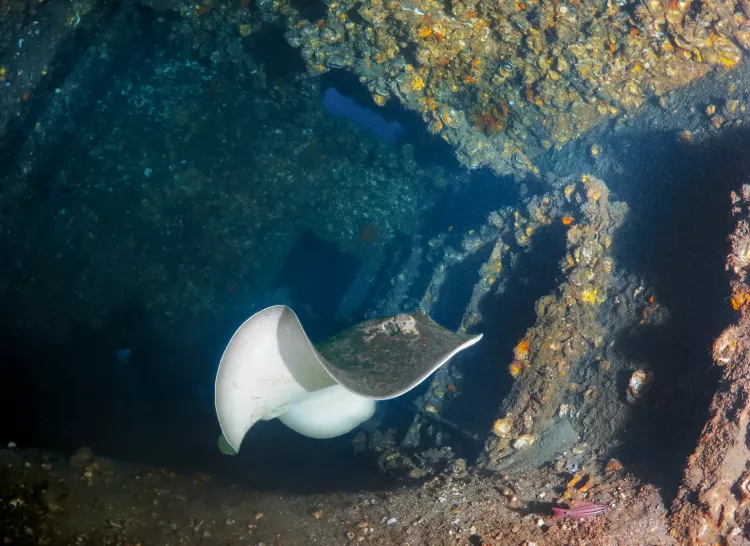
Lingyun Shipwreck
Due south of Qimei lies the wreck of a decommissioned Taiwanese Navy Lingyun-class inter-island passenger/cargo vessel, sunk twenty years ago as a fish aggregation device. It rests on its starboard side in the middle of a large sand pit at 30m. These days, it seems to attract divers, rather than fishermen, as there are no nets on it, nor is there any other sign of fishing activity.
There is not much coral growth, but there are plenty of fish and it is in the open sea, so expect some current. If the water is running, the dive boat will drop you upstream so you can drift to the wreck as you descend and then tuck in behind the ship in the calmer waters on the lee side, in the current shadow. Ideally, this will be the deck side with its superstructure and cargo booms, rather than the hull. All around the wreck, the seabed is covered in a field of white coral whips, which undulate gently in the flow.
The deck has a few large inviting holes and offers some easy swim-throughs. Outside the ship, the visibility may be poor, depending on which way the current is running, but inside, the water is gin-clear, though dark. At least, it is like that before any careless divers go in and swim too close to the silty floor.
Having said that, on this wreck, it is not always the divers that are to blame for a silted-up swim-through. Any one of the spaces you enter may already be occupied by a group of huge marble rays that live inside the ship.
On one Lingyun dive, as we drifted lazily down a corridor, our lights illuminated a bright flash of white ahead of us. Several more flashes followed. We had come upon the rays and what we were getting were glimpses of the white underside of their massive skirt-like fins as they gently circled in the darkness. As we drew closer, they became aware of us and began flapping in agitation, throwing up clouds of silt into the previously clear water and turning the visibility to zero.
Outside the wreck, you can expect to find schools of barracuda, trevally, batfish and rabbitfish as well as blue-striped angelfish and red-bar anthias. You will also see a wide variety of unusual surgeonfish, many of which do not feature in any of the standard marine life guides. This is something experienced Coral Triangle divers coming to Taiwan for the first time will notice all over the place. Many of the fish you encounter are like the ones you are used to seeing, but they have different patterns, designs and configurations.
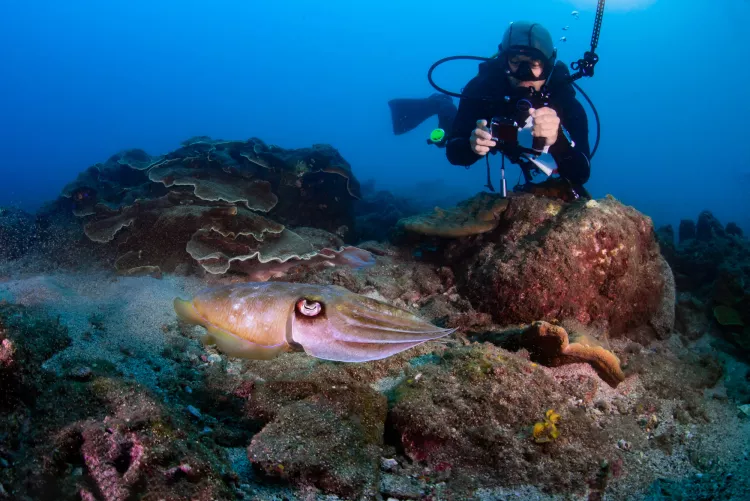
Wolf East
The dive off the south of Dongjiyu that they call Wolf East is likely to be the most exciting and rewarding of your Penghu dive trip, although, as always with big-animal encounters on land or sea, nothing is ever guaranteed. The main attraction here, apart from schools of surgeonfish, snapper and sweetlips, is a giant school of very large, fat yellowtail barracuda, which hang in the current sweeping around the tip of the island.
You drop into calm waters in the shallows and your guide leads you out to the edge of the bay, does a quick check to make sure you are ready, and then gives the signal to go. After just a few kicks, the current picks you up and sends you flying. The pattern of the dive is to fly for a while, then stop in a patch of the reef where there are bommies to hide behind, out of the main thrust of the current. A reef hook is a handy thing to have with you at this point. You wait for a few minutes to see if the barracuda come along and, if they do not, on your guide’s signal, you let go and fly off to the next stopping point. If they do show up, you hang with them for as long as you can as they swirl and surge around you.
The direction of the current flow here usually means that the farther you go, the deeper you get and, once you are deep, there is no turning back—hence the wisdom of the fly-hang-fly-hang strategy. If you were just to fly, you would soon be in water too deep for you to be able to follow the seabed down any farther and the dive would quickly be over.
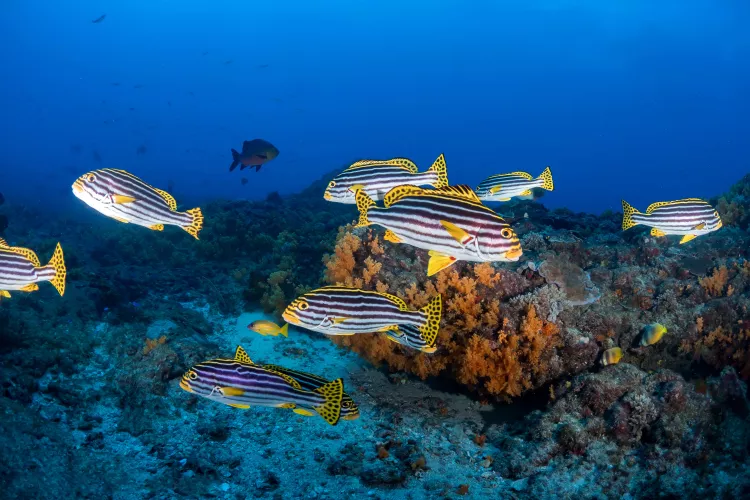
Dongxiji Channel
In-between Dongjiyu and Xijiyu, an enormous pinnacle with a series of smaller bommies around it acts as a magnet for oriental, gold-spotted and silver sweetlips, black snapper and red snapper, many and various types of surgeonfish, semi-circle angelfish, blue-lined angelfish, blue-barred parrotfish and regal angelfish. The list goes on. The rocks are completely covered in red, short, flowery algae and yellow tubastraea, making this a very scenic dive.
Again, there will be current running through the site, but navigating your way around the rocks is usually quite easy. It is worth pointing out here that Penghu, Green Island and Orchid Island are all well known for drift diving, but conditions are certainly no more difficult here than at other dive destinations elsewhere in Asia famous for strong currents, such as Komodo, Bali or Raja Ampat.
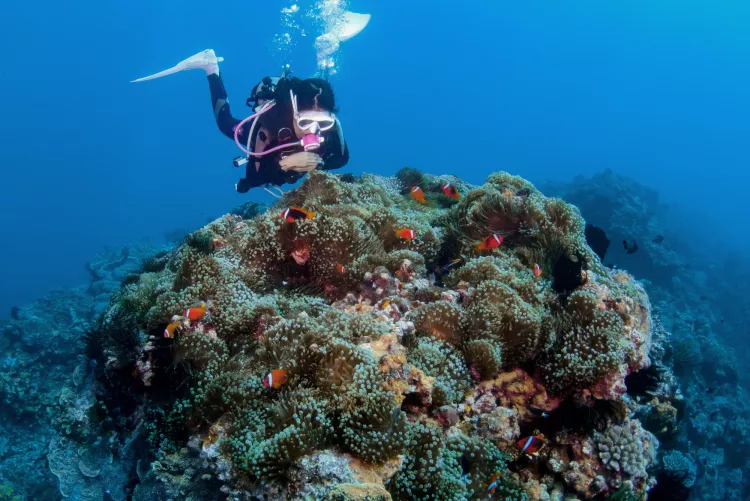
Dongjiyu Lavender Fields
These fields of lavender-blue staghorn coral are famous all over Taiwan. Along with the twin-heart-shaped fish weirs of Qimei, they are an iconic symbol of Penghu. This is mainly because they are accessible not just to divers, but snorkelers too, and a swim over the top of this reef is part of many of the island-hopping tours.
At depths of 6m and less, the purple staghorn is juxtaposed photogenically with green cabbage coral, but this site is much more than just an Instagram moment. The shallow reef system here is in excellent shape, despite the many visitors. It is home to a whole host of smaller fish and not just the usual anthias and damsels that like to hang out in the staghorn, but also clouds of baby two-tone dartfish, lemon coral gobies, schools of sixbar wrasse, pearl-scaled angelfish, orangetail filefish and wire-net filefish. It is a small-fish fancier’s dream.
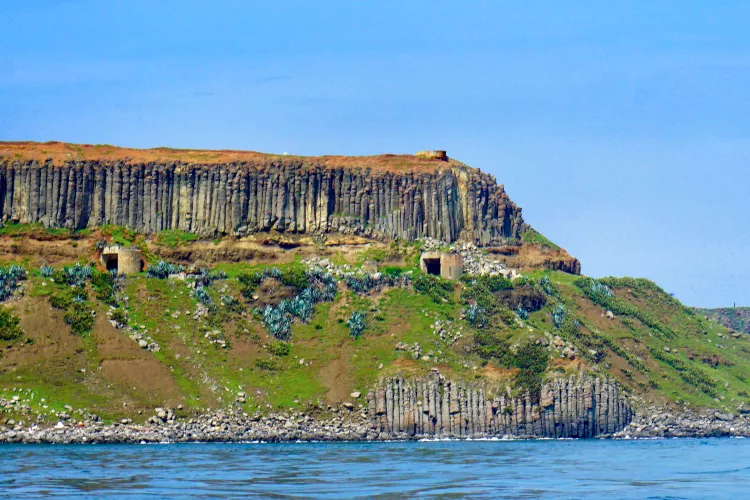
Xijiyu Basalt Ridge
The underwater ridge of basalt columns at Xijiyu is the star attraction of this particular dive. There are sea apples and nudibranchs on the ridge wall, along with small schools of reef fish and the occasional grouper, but the geology is more interesting than the biology, especially when, after the dive, the boat sails around to the other side of the island and you get up close to a similar ridge, but this time above the surface and even more impressive.
Underwater, restricted visibility prevents you from seeing the scale of the ridge. Above water, the multisided columns are stacked closely together like soldiers at attention and the parade seems to go on forever. It is as if the entire island is one huge conglomeration of basalt pillars. Some are tilted at an angle, while others have collapsed or been washed away, leaving gaps. Where the cliff line finally ends, a meadow slopes down to a rocky beach and ruined, abandoned buildings are evidence that people once lived on this island at the end of the world. Today, Xijiyu is uninhabited, and landing is not permitted.
Penghu dive operators include Gooday Dive in Magong goodaydive.com and Island 77 (facebook.com/groups/1163605790420843/).

